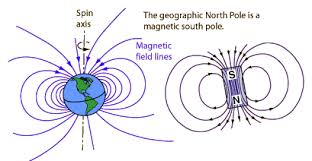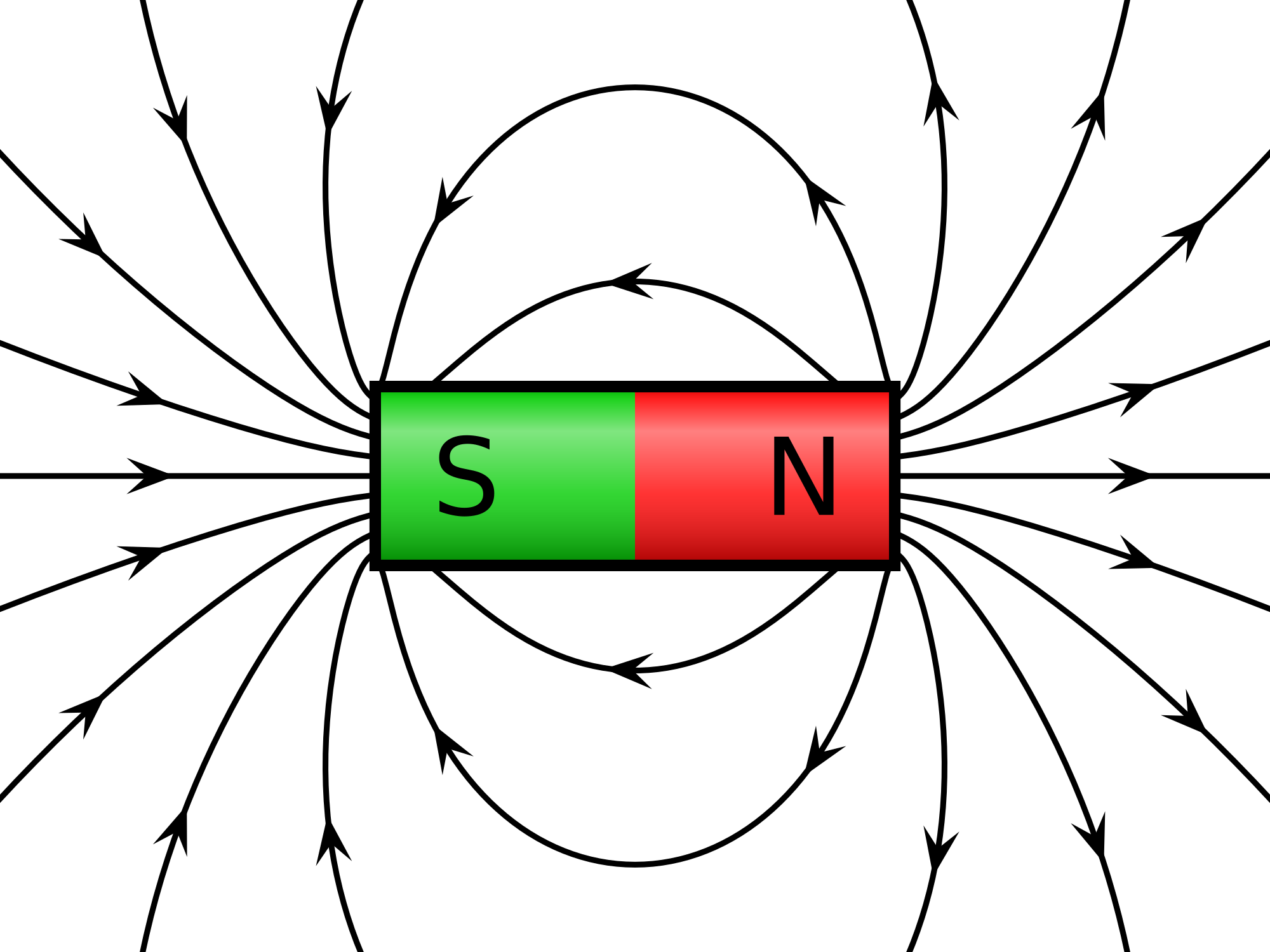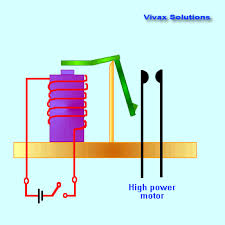(Reviewed and updated on 03/06/2016):
The magnetic field is strongest at the poles, where the field lines are most concentrated.
---------------------------------------------------
ii) A diagram of the magnetic field produced by a current-carrying wire is shown below:


------------------------------------------------------------------------------
This direction always begins at the north pole and ends at the south pole.
At the geographic north of our Earth, there appears to be a magnetic south pole; and conversely, at the geographic south, there appears to be a magnetic north pole - pl. see diagram below:

--------------------------------------------------------------------------------

 The direction of the field lines
inside the solenoid is opposite to the direction of the field lines outside it.
The direction of the field lines
inside the solenoid is opposite to the direction of the field lines outside it.
i.
Ferromagnetic
Materials and Non-Magnetic Materials:
a.
Materials
which are attracted to magnets are
known as ferromagnetic materials or
simply as ferrous or magnetic materials. These include, iron, cobalt and nickel as well as
the iron-containing alloy, steel.
b.
Materials
which are not attracted to magnets
are known as non-magnetic materials.
These include glass, wood and such metals as aluminium, zinc, lead, copper, silver, gold and alloy such
as brass.
ii.
Magnetic
Field (Definition, Causes, Direction and Poles):
a.
Definition:
A magnetic field is a space within
which a magnetic material and a magnet would experience a force.
b.
Causes:
A magnetic field is created
around:
i.
a magnet such as lodestone and artificial magnet;
ii.
a current-carrying conductor (including electromagnet);
iii. the rotating Earth.
------------------------------------------------------
i) Magnetic Field Lines of Bar Magnet:

In the diagram, note that:
* the field lines have arrows on them
iii. the rotating Earth.
------------------------------------------------------
i) Magnetic Field Lines of Bar Magnet:

In the diagram, note that:
* the field lines have arrows on them
* the field lines come out of N and go into S
* the field lines are more concentrated at the poles.
---------------------------------------------------
ii) A diagram of the magnetic field produced by a current-carrying wire is shown below:
c.
Direction of Magnetic Lines of Force:
The direction of the magnetic lines of force at any point within a magnetic field is the direction:
i. that a free north pole placed at that point would move; or,
The direction of the magnetic lines of force at any point within a magnetic field is the direction:
i. that a free north pole placed at that point would move; or,
ii. that a plotting compass placed at that point
would point.
This direction always begins at the north pole and ends at the south pole.
At the geographic north of our Earth, there appears to be a magnetic south pole; and conversely, at the geographic south, there appears to be a magnetic north pole - pl. see diagram below:
--------------------------------------------------------------------------------
d.
Poles of Magnet:
i.
North
pole of a magnet refers to that part of the magnet which would repel the
north pole of another magnet or which would be attracted to the south pole of
another magnet. When a bar magnet is freely suspended (as in a compass), the north pole (arrow-head) would point approximately to the
geographic north of the Earth which contains a magnetic south pole.
ii.
South
pole of a magnet refers to the pole which
is opposite to and attracts the north pole of the magnet. When a bar magnet is freely suspended, the south pole would approximately point to the Earth’s geographic south which contain a magnetic north pole.
iii.
A magnet,
depending on its shape, invariably
has at least a pair of opposite poles.
iii.
Magnetic
Field (pattern, direction, strength) in Current-Carrying Conductor:
i.
When there is current flowing in a
conductor, a magnetic field is created in the space around the conductor. And, the conductor may be of any shape such as:
a.
a
straight wire
b.
a coil;
or,
c.
a
solenoid (multiple continuous coils)
ii.
The pattern and direction of the magnetic field
created due to current in a conductor depends on the shape of the conductor and the direction of current:
a.
In a Straight Wire
i.
The pattern
of magnetic field lines is that of
concentric circles around the conductor.
ii.
The direction
of the magnetic field lines may be summarized by:
1.
Right-hand Grip Rule (diagram above); or,
2.
Maxwell’s Screw Rule (diagram below)
iii.
The strength
of the magnetic field is:
1.
stronger near the current than further away
2.
stronger when the current is increased
iv.
when the direction of the current changes,
1.
the pattern
remains the same
2.
the direction
of the magnetic field lines reverses
3.
the strength
of the magnetic field depends on the same two factors:
a.
proximity (nearness) to current; and,
b.
size of the current.
b.
In
a Coil
Magnetic Field Around a Coil
i.
The pattern
of magnetic field lines is that of
compressed circles around the conductor with the circles flattened within the
coil resulting in the lines more closely spaced within the coil than outside it
and at the centre, the line is straight.
ii.
The direction
of the magnetic field lines around the coil at any point may be summarized by
1.
Right-hand Grip Rule;
2.
Looking at the direction of the current from
each end of the coil.
The field lines around the two
wires are in opposite direction.
iii.
The strength
of the magnetic field is:
1.
stronger within the coil than outside the coil;
and,
2.
stronger when the current is increased
iv.
when the direction of the current reverses,
1.
the pattern
remains the same;
2.
but the direction
of the magnetic field lines around each wire reverses;
3.
the strength
of the magnetic field depends on the same factors:
a.
stronger within the coil; and,
b.
stronger when the current increases.
c. Magnetic Field Around a Solenoid


i.
The pattern
of magnetic field lines is that of
compressed circles around the conductor with the circles flattened within
the solenoid resulting in the lines more closely and evenly spaced within the
coil than outside it and at the centre, the line is straight.
ii.
The direction
of the magnetic field lines around the solenoid and the north pole and south
pole of the solenoid may be summarized by
1.
Right-hand
Grip Rule; or,

2.
Looking at the direction of the current from
each end of the solenoid.
iii.
The strength
of the magnetic field is:
1.
stronger and more even within the solenoid than
outside the coil; and,
2.
stronger when the current is increased
iv.
when the direction of the current reverses,
1.
the pattern
remains the same;
2.
but the direction
of the magnetic field lines around each wire reverses;
3.
the strength
of the magnetic field depends on the same factors:
a.
stronger within the coil; and,
b.
stronger when the current increases.
v. Experiment in Activity 3.3 at pg. 402
provides the above facts.
iii.
Factors
Affecting Strength of Electromagnet
a.
An electromagnet is a temporary magnet
consisting of soft ferromagnetic material (usually soft iron) surrounded by
solenoid of many turns of insulated copper wire. When current flows through the
solenoid, the soft ferromagnetic material becomes a magnet; when the current is
switched off, the magnetism is lost.
b.
A simple electromagnet consists of a soft iron
core surrounded by a solenoid.
c.
The strength of an electromagnet depends on:
i.
The size of the current flowing through the
solenoid
ii.
The number of turns of the coils in the solenoid
iii.
The soft ferromagnetic material used – soft iron
being ideal
iv.
The shape of the soft ferromagnetic material
used – M-shaped being better than U-shaped; and U-shaped being better than a
cylindrical core;
iv.
Uses of Electromagnets
a.
Electromagnetic
Lifting Machine

b.
The
Electric Bell

c.
The
Electromagnetic Relay

e.
The
Circuit Breaker
The Working Of A Circuit Breakers Through A Diagram :

The Working Of A Circuit Breakers Through A Diagram :






No comments:
Post a Comment